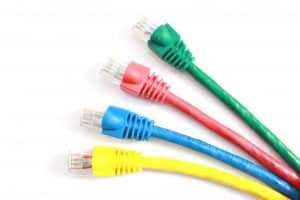Cabling is the set of wires made of either copper or glass that is used to connect computers and other network components to enable them to communicate, thus forming a network of computers.
What is Network Cabling?
In other words, Network Cabling is the medium through which information usually moves from one network device to another. There are several types of cable which are commonly used with LANs. In some cases, a network will utilize only one type of cable, other networks will use a variety of cable types. The type of cable chosen for a network is related to the network’s topology, protocol, and size. Understanding the characteristics of different types of cable and how they relate to other aspects of a network is necessary for the development of a successful network.
Laying cables is the foundation for both creating local area networks (LANs) and connecting LANs into wide area networks (WANs). Network administrators are usually involved only in the planning and laying of LAN cabling since WAN cabling is the responsibility of telecommunications carriers.

How Cabling Works
There are two basic types of cabling used in LAN networking environments:
- Copper cabling, which consists of insulated copper conductors that transmit signals using electrical voltages and currents. Copper cabling can be either coaxial cabling (such as thinnet or thicknet) that is used mainly in industrial environments, or the more commonly employed twisted-pair cabling. Twisted-pair cabling comes as either unshielded twisted-pair (UTP) cabling (commonly used in Ethernet or Fast Ethernet environments) or the less common shielded twisted-pair (STP) cabling (employed for token ring networks and sometimes for Gigabit Ethernet installations). Copper cabling is mainly used for shorter cable runs such as horizontal cable runs between wiring closets and wall plates in work areas, for patch cables, and for equipment interconnects.
- Fiber-optic cabling, which is made of glass strands that transmit signals as light waves or pulses. Fiber-optic cabling can be either single-mode, which is used for the longest cable runs, or multimode, which has a much higher carrying capacity. Fiber-optic cabling is generally used for backbone cable runs such as vertical rises in buildings and building-to-building interconnects on a campus, for high-speed interconnects between networking devices in a wiring closet, and for connections to high-speed servers and workstations.
The Telecommunications Industry Association (TIA) and Electronic Industries Alliance (EIA) have defined a series of standards on proper layout and organization of premise cabling called the EIA/TIA wiring standards. Cabling installed in a building must meet all legal requirements, including federal and local building regulations. Do not attempt to wire a building unless you are fully familiar with the required regulations. The EIA/TIA-568A Commercial Building Telecommunication Cabling Standard specifies standards for each of the following:
- Establishing wiring closets on each floor of the building to contain rack-mounted equipment such as hubs, switches, and patch panels;
- Running vertical backbone plenum cabling through building risers and building plenums, for connecting wiring closets to the main equipment room;
- Running horizontal PVC (polyvinyl chloride) cabling for each floor through false ceilings;
- Connecting the patch panels in the wiring closet to wall plates in computer work areas.
Specialized cables – such as serial, parallel, or SCSI cables – are used to connect peripherals, and therefore do not serve the same purpose as the cables just discussed. Serial cables and other special-purpose cables are generally very short and are not permanently installed. Cabling for a LAN must be installed according to the standards described in the previous list. Not all networks use physical cabling. Wireless networks can use infrared, microwave, radio, or some other form of electromagnetic radiation to allow networking components to communicate with each other.
Categories of Unshielded Twisted Pair
The quality of UTP may vary from telephone-grade wire to extremely high-speed cable. The cable has four pairs of wires inside the jacket. Each pair is twisted with a different number of twists per inch to help eliminate interference from adjacent pairs and other electrical devices. The tighter the twisting, the higher the supported transmission rate and the greater the cost per foot. The EIA/TIA (Electronic Industry Association/Telecommunication Industry Association) has established standards of UTP and rated six categories of wire (additional categories are emerging).
| Category | Speed | Use |
| 1 | 1 Mbps | Telephone and modem lines |
| 2 | 4 Mbps | LocalTalk & Telephone |
| 3 | 16 Mbps | 10BaseT Ethernet |
| 4 | 20 Mbps | Token Ring |
| 5 | 100 Mbps (2 pair) | 100BaseT Ethernet |
| 5e | 100 Mbps (4 pair) | 100BaseT Ethernet |
| 6 | 1,000 Mbps | Gigabit Ethernet |
| 7 | 10,000 Mbps | Gigabit Ethernet |
| 8 | 10,000 Mbps | Gigabit Ethernet |
Choosing the right kind of cabling
Choosing the right kind of cabling at the beginning of installation can save considerable expense when networking equipment is later upgraded for higher transmission speeds.
To learn more about Cabling you have to check this book by Sybex, Cabling: The Complete Guide to Copper and Fiber-Optic Networking.